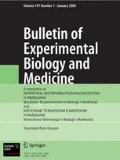Cell—cell interactions and the ability of mesenchymal stromal cells to support the expansion of hematopoietic progenitor cells were studied in co-culture of human umbilical cord tissue-derived mesenchymal stromal cells and nucleated umbilical cord blood cells. It was found that hematopoietic stem cells from the umbilical cord blood are capable to adhere to mesenchymal stromal cells and proliferate during 3-4 weeks in co-culture. However, despite the formation of hematopoietic foci and accumulation of CD34+ and CD133+ cells in the adherent cell fraction, the ability of newly generated blood cells to form colonies in semi-solid culture medium was appreciably reduced. These findings suggest that human umbilical cord tissue-derived mesenchymal stromal cells display a weak capability to support the “stemness” of hematopoietic stem cell progeny despite long-term maintenance of their viability and proliferation.
Similar content being viewed by others
References
Bai L, Li D, Li J, Luo Z, Yu S, Cao S, Shen L, Zuo Z, Ma X. Bioactive molecules derived from umbilical cord mesenchymal stem cells. Acta Histochem. 2016;118(8):761-769.
Bakhshi T, Zabriskie RC, Bodie S, Kidd S, Ramin S, Paganessi LA, Gregory SA, Fung HC, Christopherson KW 2nd. Mesenchymal stem cells from the Wharton’s jelly of umbilical cord segments provide stromal support for the maintenance of cord blood hematopoietic stem cells during long-term ex vivo culture. Transfusion. 2008;48(12):2638-2644.
Ballen KK, Gluckman E, Broxmeyer HE. Umbilical cord blood transplantation: the first 25 years and beyond. Blood. 2013;122(4):491-498.
Beksac M. Is there any reason to prefer cord blood instead of adult donors for hematopoietic stem cell transplants? Front. Med. (Lausanne). 2016;2:95. doi: https://doi.org/10.3389/fmed.2015.00095.
Broxmeyer HE. Umbilical cord transplantation: epilogue. Semin. Hematol. 2010;47(1):97-103.
Flores-Guzmán P, Fernández-Sánchez V, Mayani H. Concise review: ex vivo expansion of cord blood-derived hematopoietic stem and progenitor cells: basic principles, experimental approaches, and impact in regenerative medicine. Stem Cells Transl. Med. 2013;2(11):830-838.
Gluckman E, Broxmeyer HA, Auerbach AD, Friedman HS, Douglas GW, Devergie A, Esperou H, Thierry D, Socie G, Lehn P, Cooper S, English D, Kurtzberg J, Bard J, Boyse EA. Hematopoietic reconstitution in a patient with Fanconi’s anemia by means of umbilical-cord blood from an HLA-identical sibling. N. Engl. J. Med. 1989;26(321(17):1174-1178.
Gluckman E, Rocha V. Cord blood transplantation: state of the art. Haematologica. 2009;94(4):451-454.
Kalaszczynska I, Ferdyn K. Wharton’s jelly derived mesenchymal stem cells: future of regenerative medicine? Recent findings and clinical significance. Biomed. Res. Int. 2015;2015. ID 430847. doi: 10.1155/2015/430847.
Kwon A, Kim Y, Kim M, Kim J, Choi H, Jekarl DW, Lee S, Kim JM, Shin JC, Park IY. Tissue-specific differentiation potency of mesenchymal stromal cells from perinatal tissues. Sci. Rep. 2016;6. ID 23544. doi: 10.1038/srep23544.
Maslova EV, Andreeva ER, Andrianova IV, Bobyleva PI, Romanov YA, Kabaeva NV, Balashova EE, Ryaskina SS, Dugina TN, Buravkova LB. Enrichment of umbilical cord blood mononuclears with hemopoietic precursors in co-culture with mesenchymal stromal cells from human adipose tissue. Bull. Exp. Biol. Med. 2014;156(4):584-589.
Metheny L, Caimi P, de Lima M. Cord blood transplantation: can we make it better? Front. Oncol. 2013;3:238. doi: https://doi.org/10.3389/fonc.2013.00238.
Pires AO, Mendes-Pinheiro B, Teixeira FG, Anjo SI, Ribeiro-Samy S, Gomes ED, Serra SC, Silva NA, Manadas B, Sousa N, Salgado AJ. Unveiling the differences of secretome of human bone marrow mesenchymal stem cells, adipose tissue-derived stem cells, and human umbilical cord perivascular cells: A proteomic analysis. Stem Cells Dev. 2016;25(14):1073-1083.
Romanov YA, Balashova EE, Bystrykh OA, Titkov KV, Dugina TN, Kabaeva NV, Fedorova TA, Rogachevskii OV, Degtyarev DN, Sukhikh GT. Umbilical cord blood for autologous transfusion in the early postnatal ontogeny: analysis of cell composition and viability during long-term culturing. Bull. Exp. Biol. Med. 2015;158(4):523-527.
Romanov YA, Balashova EE, Volgina NE, Kabaeva NV, Dugina TN, Sukhikh GT. Changes in cell composition of umbilical cord blood and functional activity of hematopoietic stem cells during cryogenic storage and repeated freezing/thawing cycles. Bull. Exp. Biol. Med. 2016;160(4):571-574.
Romanov YA, Balashova EE, Volgina NE, Kabaeva NV, Dugina TN, Sukhikh GT. Isolation of multipotent mesenchymal stromal cells from cryopreserved human umbilical cord tissue. Bull. Exp. Biol. Med. 2016;160(4):530-534.
Romanov YA, Balashova EE, Volgina NE, Kabaeva NV, Dugina TN, Sukhikh GT. Optimized protocol for isolation of multipotent mesenchymal stromal cells from human umbilical cord. Bull. Exp. Biol. Med. 2015;160(1):148-154.
Sotnezova EV, Andreeva ER, Grigoriev AI, Buravkova LB. Ex vivo expansion of hematopoietic stem and progenitor cells from umbilical cord blood. Acta Naturae. 2016;8(3):6-16.
Sotnezova EV, Gornostaeva AN, Andreeva ER, Romanov YA, Balashova EE, Buravkova LB. Effect of stromal cells and oxygen concentration on the maintenance of cord blood hematopoietic precursors. Tsitologiia. 2015;57(6):428-435.
Walenda T, Bork S, Horn P, Wein F, Saffrich R, Diehlmann A, Eckstein V, Ho AD, Wagner W. Co-culture with mesenchymal stromal cells increases proliferation and maintenance of haematopoietic progenitor cells. J. Cell. Mol. Med. 2010;14(1-2):337-350.
Watson N, Divers R, Kedar R, Mehindru A, Mehindru A, Borlongan MC, Borlongan CV. Discarded Wharton jelly of the human umbilical cord: a viable source for mesenchymal stromal cells. Cytotherapy. 2015;17(1):18-24.
Author information
Authors and Affiliations
Corresponding author
Additional information
Translated from Kletochnye Tekhnologii v Biologii i Meditsine, No. 2, pp. 71-76, June, 2017
Rights and permissions
About this article
Cite this article
Romanov, Y.A., Volgina, N.E., Balashova, E.E. et al. Human Umbilical Cord Mesenchymal Stromal Cells Support Viability of Umbilical Cord Blood Hematopoietic Stem Cells but not the “Stemness” of Their Progeny in Co-Culture. Bull Exp Biol Med 163, 523–527 (2017). https://doi.org/10.1007/s10517-017-3843-6
Received:
Published:
Issue Date:
DOI: https://doi.org/10.1007/s10517-017-3843-6


